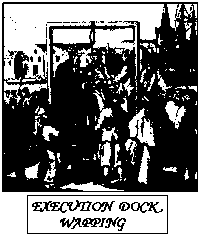 Lifestyle
Lifestyle Lifestyle
Lifestyle The pirate flag was designed to
strike fear into victims and encourage a hasty surrender, however, the black
Jolly Roger, commonly associated with pirates, was not as greatly feared as the
red flag which meant that no mercy would be shown in battle.
The pirate flag was designed to
strike fear into victims and encourage a hasty surrender, however, the black
Jolly Roger, commonly associated with pirates, was not as greatly feared as the
red flag which meant that no mercy would be shown in battle.
The Jolly Roger often depicted symbols of death (a skull and crossbones was commonly seen on grave stones) and may have got its name from the devil -Old Roger - but is more likely derived from the French name for the red flag - Jolie Rouge.

When they reached a port, if the trip had been successful, the pirates squandered their ill-gotten gains on gambling, drink and women often spending thousands of pieces-of-eight in a night (in these days 2 pieces-of-eight bought a cow!). Alexander Exquemelin noted that the pirates wasted in a few days in the taverns and stews all they had gotten, by giving themselves to all manner of debauchery with strumpets and wine.
However, there was also work which had to be carried out before the pirates could sail again. The successful pirate ensured that the ship was kept in good working order, this meant careening the ship (scraping the weed and barnacles from the bottom of the ship) as well as repairing sails and rigging. Other crew members would have the job of finding fresh supplies of water and food for the next voyage.
Life at sea was one of great contrasts, week of boredom searching for prey then short bursts of excitement as a victim was sighted, boarded and plundered. During the long, boring spells it was not uncommon for arguments to arise among crew members, at such times the captain had to control his crew through either respect or fear. In many cases the captain did not have the last word as many pirate crews were run democratically and often had a strict code of conduct.
These rules were used to settle the arguments, ensure that booty was equitably shared and to see that pirates injured whilst on active service were compensated. Captain Charles Johnson gives some examples:
 The preservation of food was a
major problem for pirates. Bottles of beer were preferred over water which
quickly became undrinkable, the staple food was hard tack (long-lasting
biscuits). For very long voyages limes would provide vitamin C to hopefully
prevent scurvy and hens on board the ship could provide both fresh eggs and meat
(good sources of protein).
The preservation of food was a
major problem for pirates. Bottles of beer were preferred over water which
quickly became undrinkable, the staple food was hard tack (long-lasting
biscuits). For very long voyages limes would provide vitamin C to hopefully
prevent scurvy and hens on board the ship could provide both fresh eggs and meat
(good sources of protein).
The main source of meat was the turtles which thrived in the Caribbean. These creatures although agile in the sea were slow and clumsy on the land and therefore easy prey for the pirates.
 Although the rewards
of piracy could be great, the punishment for convicted pirates was to dance the
hempen jig, the pirates term for being hung. The hanging was a public event
which, in London, always took place at Execution Dock at Wapping.
Although the rewards
of piracy could be great, the punishment for convicted pirates was to dance the
hempen jig, the pirates term for being hung. The hanging was a public event
which, in London, always took place at Execution Dock at Wapping.
The convicted pirates were taken from the Marshalsea Prison or Newgate in a procession led by an officer carrying the silver oar, which symbolized the authority of the High Court of the Admiralty, to the wooden gallows at the low-tide mark. After a sermon from the chaplain the pirate was allowed to address the crowd before being executed. After execution the bodies were left until three tides had passed over them.

Privateers faced only imprisonment if captured and the possibility that they might be set free as part of an exchange of prisoners. Prison was a poor alternative, the gaols or prison hulks (converted naval ships that were no longer seaworthy) were damp and disease-ridden and in many cases consignment to these was a prolonged death sentence.
